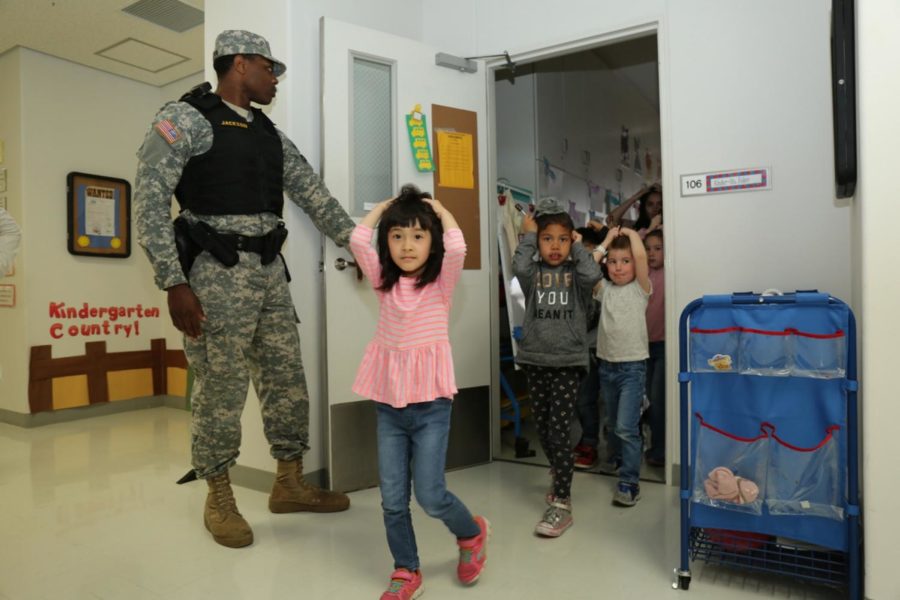Noriko Kudo, U.S. Army Garrison Japan Public Affairs
Recent shootings ignite concern in lockdown procedures
With another shooting event in Florida Monday Feb. 15, Americans are re-evaluating the current safety measures in an effort to protect the community in case of an active shooter event. Now, no matter how unexpected this type of event may be, protocol that deals with safety is being taken into consideration by authorities, including those at Orono High School.
“Sadly, in this society, active shooter is a scenario in which every school has to be prepared for,” science teacher Suzanne Kehret said.
Yet, with all of the current circulation of emergency plans today, shooter safety at Orono High School is not as well-known, according to several other students and staff.
In the case of an emergency, there are three different types of lockdowns, according to the Orono Public Schools Emergency Plan pamphlet. In general, a Lockdown with Warning occurs when the problem is physically outside the building. As soon as the threat is inside, the event becomes a Lockdown with Intruder, which prompts the response of gathering in the corners of the classrooms. Specifically, in the case of an active shooter, the directions are to follow regular lockdown procedures.
Outside of the classroom pamphlets, there is little information about what to do in the event of a lockdown. According to the OHS Parent-Student Handbook, it references that protocol is established and is expected to be followed, yet there is no direct mention of the specified protocol. Similarly, in other school handbooks from metro schools such as Wayzata, Delano, and Mound Westonka, the instructions identify to follow procedure and direction of faculty.
In all these district instructions, regardless of the wording, student knowledge of the specific lockdown procedures remains hazy.
“We don’t really have lockdown drills very often and [the drills] aren’t taken very seriously,” senior Sydney Donaldson said. “I don’t even remember the last time we had a lockdown drill, to be honest.”
In a recent poll conducted with students and staff of OHS, 17 percent of people could correctly identify the three types of response, yet 93 percent responded positively when asked if they knew what to do in a lockdown situation. Only 39 percent of students and faculty said that they could remember the last time a lockdown drill was conducted.
As a result, students and staff at OHS said that they are concerned about this confusion regarding the practicality in the practice.
“If there was a shooter in the school, I probably wouldn’t listen to my teacher; I’d just try to get out,” freshman Matt Hartung said.
In addition to the current procedures, Kehret said that as of last November, Orono Schools are trying to implement the copyrighted program “Run, Hide, Fight” in the case of an active shooter. According to the FBI “Run, Hide, Fight” Informational Video: first, the program encourages victims to run if given the chance with a map in mind towards safety. If not possible, the next option is to hide behind big objects, barricading any entrances nearby. When necessary, one might have to fight, creating impromptu weapons and acting with extreme force.
The Orono Schools District is always undergoing updates to regulations as new data and incidents arise, according to the Coordinator of Facilities and Safety Justin McCoy. Currently, “Run, Hide, Fight” is in the process of implementation, starting with the training of staff. Nevertheless, if there were an active shooter incident today, standard methods would be taken, as the district only plans to supplement “Run, Hide, Fight” with the present Lockdown with Intruder method.
“What we know from recent events, lockdown alone is no longer enough,” McCoy said. “If an incident would occur at Orono, staff have been given the freedom to make a decision on what’s the safest situation for their students based on the information they have been given regarding the incident.”
Since the most recent shooting, little has been changed at the national level in regards to ratification of the safety programs. Of the 178 School Emergency Planning bills that were proposed, only 43 were enacted into law while the rest died or are still pending in legislature, according to Education Week. At the state level, only one school-related bill has been passed in Minnesota currently regarding the report of bullying incidents on report cards. Nevertheless, the growing awareness of the effectiveness of “Run, Hide, Fight” has spread across the metro, currently being practiced in schools such as Plymouth.
Currently, “Run, Hide, Fight” is presently the focus for change in the safety drill procedures, although some students share other ideas for improvement. Franklin Koch, a freshman, offered the idea of holding a district-wide assembly to discuss the recent news as well as the importance of safety drills. He also said that having actors come reenact an active shooter scenario would help students practice the realistic aspect of the procedure.
As the shooter scenarios continue, the significance of practice continues to be an emphasis at OHS.
“So much of what happens in an emergency is instinct, so if you don’t practice, you’ll react, but your reaction has to be the best response to that situation,” Kehret said. “It’s about teaching adaptability…and that takes practice.”
If you have any additional questions about Orono protocol and safety, here is a link to the official training video: https://vimeo.com/255953493.

